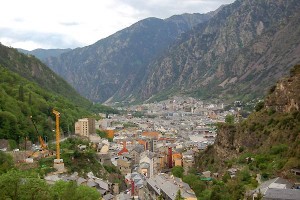 I like standing high on a ridge looking into a rugged mountain-ringed basin, where nature cradles an ancient tribe. Located in the former Yugoslavia, it’s looking down on the royal city of Cetinje, the historic capital of Montenegro — Europe’s newest country (independent for about one year)…a land where you expect to see short men with long beards. It’s so humble that when the Turks came in to rape, pillage and plunder, they decided it just wasn’t worth the trouble, rolled up their carpets and went home. (I’ll be there later in this blog.)
I like standing high on a ridge looking into a rugged mountain-ringed basin, where nature cradles an ancient tribe. Located in the former Yugoslavia, it’s looking down on the royal city of Cetinje, the historic capital of Montenegro — Europe’s newest country (independent for about one year)…a land where you expect to see short men with long beards. It’s so humble that when the Turks came in to rape, pillage and plunder, they decided it just wasn’t worth the trouble, rolled up their carpets and went home. (I’ll be there later in this blog.)
A few days ago, my TV crew and I drove and drove to finally stand high in the Pyrenees Mountains, which separate France and Spain. Before us lay the principality of Andorra.
Europe’s midget countries have an undeniable curiosity factor. In Europe’s tiny derby, the Vatican is the big little winner. Then comes Monaco…San Marino…Liechtenstein…Malta (which, while an island in the Mediterranean, is considered part of Europe) and finally — measuring in at about 13 miles by 13 miles, with 80,000 people — Andorra. (We’re now four-fifths finished with a TV show featuring these little guys. Only Liechtenstein — also later in this blog — remains.) All of these countries would fit easily into Europe’s next smallest country…the relatively vast Luxembourg.
Andorra has a long history. In their national anthem, Andorrans sing of Charlemagne rescuing their land from the Moors in 803. In the 13th century, Spanish and French nobles married. They agreed that the principality would be neither Spanish nor French. This unique feudal arrangement survives today. And, while they have co-princes from other countries (the president of France and a Spanish bishop), locals stress that Andorra is 100 percent independent.
Until little more than a generation ago, Andorra was an impoverished and isolated backwater. Puny 12th-century churches and their stony bell towers stand as strong as the Pyrenees around them.
Recently, Andorrans have become wealthy — thanks to the same mountains that kept them so isolated and poor for so long. Hiking and skiing are big business, stoking a building boom. Huge Vail-like ski-condos, built of perfectly crafted rustic stone, both contrast and match the historic stone buildings they now dwarf and outnumber.
And Andorra employs those special economic weapons so popular among Europe’s little states: easygoing banking, duty-free shopping and low, low taxes. The principality has morphed from a rough-and-tumble smugglers’ haven to a high-tech, high-altitude shoppers’ haven — famous for its bargain-basement prices. More than 10 million visitors — mostly Spaniards and French, enduring famous traffic jams — pour in yearly to buy luxury goods, electronics and other goodies while avoiding their high taxes back home.
The country’s capital and dominant city is Andorra la Vella. On my first visit here back in the 1970s, I remember it felt like a big Spanish-speaking Radio Shack. Today, it retains the charm of a giant shopping mall. I didn’t tell the tourist board, who kindly helped us film, but if people ask, “Why Andorra?” I have to answer, “I go there so you won’t have to.”



